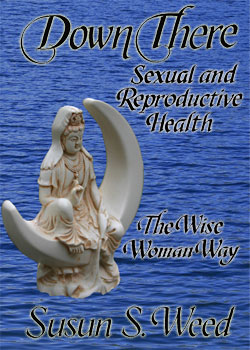www.susunweed.com
Chickweed Is A Star
c. 2007, Susun WeedAs seen printed in Mystic Pop Magazine
Snowdrops and crocus flowers herald the spring. And if you look in between them, with luck, you'll see a bright green creeping plant low to the ground with little white starry flowers: chickweed, a good friend of mine.
I say she's a star, because her botanical name -- Stellaria media -- means little stars. And because she really stars at helping us when we need to gently dissolve something or to cool off inflamed tissues. Chickweed not only effects physical health, she is a psychic healer too. She opens us up to cosmic energies and gives us the inner strength we need to handle those energies.
Chickweed contains soapy substances, called saponins. Saponins, like soap, emulsify and increase the permeability of cellular membranes. When we consume chickweed those saponins increase our ability to absorb nutrients, especially minerals. They also dissolve and break down unwanted matter, including disease-causing bacteria, cysts, benign tumors, thickened mucus in the respiratory and digestive systems, and excess fat cells.
Yes, you heard me correctly, drinking chickweed infusion can eliminate fat cells. I put one ounce of dried herb (I weigh it) in a quart jar and fill it to the top with boiling water. I cap it tightly and wait for at least four hours, then strain and drink it, hot or cold, with honey or miso. What I don't consume right away, I store in the refrigerator. A quart a day is not too much to drink, but even two cups a day can help you shed those unwanted pounds. (Do remember though that subcutaneous fat, the kind you can pinch, is healthy for women, so don't get too thin.)
Chickweed's ability to break cells open helps it get rid of bacterial infections when applied as a poultice. It is every mother's favorite for dealing with children's eye infections (pink eye). I crush a small handful of the fresh herb until it is juicy, then apply it directly to the troubled eye or infected wound, covering the chickweed with a small towel to keep it in place. I leave the poultice until the chickweed heats up, which indicates to me that bacteria are dying. Then I remove the poultice and throw the plant material away. It is critically important to use fresh chickweed for each application so bacteria are not reintroduced. Generally symptoms will at least start to go away after the first application, but using several more chickweed poultices, once or twice a day for several more days, will insure full healing.
Our beautiful star is superb at dissolving cysts and benign tumors. She especially shines when it comes to getting rid of ovarian cysts. Since many doctors, frightened of ovarian cancer, are fast to suggest surgical remedies for ovarian cysts, having a safe and effective green ally can save us from major surgery. Using chickweed to dissolve a cyst or benign tumor is a slow process, and requires consistency. It also requires chickweed tincture made from fresh, not dried, plant material. You can buy the tincture already made. Or make you own: Fill any jar, large or small, with fresh chopped chickweed and 100 proof vodka. Wait six weeks and it's ready to use. A dropperful of the tincture taken 2-3 times a day for 2-16 months is the usual course.
I have seen chickweed dissolve ovarian cysts as large as an orange. One women used it to get rid of a dermoid cyst (which contains hair, bones, teeth, and fingernails); for that, she combined the chickweed with motherwort (Leonurus cardiaca) and cronewort (Artemisia vulgaris) tinctures in equal parts. These three plants together are an ancient Chinese remedy for many "women's problems."
Chickweed loves the cool weather of spring and autumn; she hides when summer's sun is high. This gives her a great ability to cool things off for us when we are overheated. I believe that sub-clinical inflammations are responsible for many of the chronic problems we have, including joint pain, digestive upsets, blood vessel disease, memory problems, and even some cancers. Regular use of chickweed takes the heat out and allows optimum functioning.
Women with "hot" bladders -- such as those interstitial cystitis, chronic cystitis, or a bladder irritated by childbirth or abdominal surgery -- adore chickweed. She soothes and cools, removes bacteria, and strengthens the bladder wall. What a star!
But don't wait for a problem to get to know chickweed. She is delicious and ever so happy to jump into your salad bowl and share her star qualities with you.
Chickweed is loaded with nutrition, being high in chlorophyll, minerals -- especially calcium, magnesium, manganese, zinc, iron, phosphorus, and potassium, vitamins -- especially C, A (from carotenes), and B factors such as folic acid, riboflavin, niacin, and thiamine.
No wonder old-time herbals recommend chickweed for "convalescents, weak children, the anemic, and the old." Chickweed infusion is also a blessing for those recovering from surgery. (Tinctures are not nutritious.)
I'm going to grab my scissors and my basket and go outside and pick a bunch of chickweed and make this yummy spring salad: 4 cups fresh chickweed, 2 cups fresh watercress or miner's lettuce, 1 cup fresh flowers, such as violets, and 2 tablespoons of finely-chopped wild chives. I dress it with olive oil, tamari, and whatever herbal vinegar strikes my fancy, or just plain apple cider vinegar.
There's lots more information on the little star lady chickweed in my book Healing Wise. It's green, like chickweed, like the blessings the Earth offers us so freely. So, grab your scissors, and go harvest some chickweed for dinner tonight. You'll make a new friend who can really help when times are tough.
Susun Weed
PO Box 64
Woodstock, NY 12498
Fax: 1-845-246-8081
Vibrant, passionate, and involved, Susun Weed has garnered an international reputation for her groundbreaking lectures, teachings, and writings on health and nutrition. She challenges conventional medical approaches with humor, insight, and her vast encyclopedic knowledge of herbal medicine. Unabashedly pro-woman, her animated and enthusiastic lectures are engaging and often profoundly provocative.
Susun is one of America's best-known authorities on herbal medicine and natural approaches to women's health. Her four best-selling books are recommended by expert herbalists and well-known physicians and are used and cherished by millions of women around the world. Learn more at www.susunweed.com
For permission to reprint this article, contact us at: susunweed@herbshealing.comSusun Weed - PO Box 64, Woodstock, NY 12498 (fax) 1-845-246-8081
Visit Susun Weed at: www.susunweed.com and www.wisewomanbookshop.com
Wise Woman Herbal for the Childbearing Year
Author: Susun S. Weed.
Simple, safe remedies for pregnancy, childbirth, lactation, and newborns. Includes herbs for fertility and birth control. Foreword by Jeannine Parvati Baker. 196 pages, index, illustrations.
Order at: www.wisewomanbookshop.com
Healing Wise
Author: Susun S. Weed.
Superb herbal in the feminine-intuitive mode. Complete instructions for using common plants for food, beauty, medicine, and longevity. Introduction by Jean Houston. 312 pages, index, illustrations.
Order at: www.wisewomanbookshop.com

NEW Menopausal Years the Wise Woman Way
Author: Susun S. Weed.
The best book on menopause is now better. Completely revised with 100 new pages. All the remedies women know and trust plus hundreds of new ones. New sections on thyroid health, fibromyalgia, hairy problems, male menopause, and herbs for women taking hormones. Recommended by Susan Love MD and Christiane Northrup MD. Introduction by Juliette de Bairacli Levy. 304 pages, index, illustrations.
Order at: www.wisewomanbookshop.com
For excerpts visit: www.menopause-metamorphosis.com
Breast Cancer? Breast Health!
Author: Susun S. Weed.
Foods, exercises, and attitudes to keep your breasts healthy. Supportive complimentary medicines to ease side-effects of surgery, radiation, chemotherapy, or tamoxifen. Foreword by Christiane Northrup, M.D. 380 pages, index, illustrations.
Order at: www.wisewomanbookshop.com
Down There: Sexual and Reproductive Health the Wise Woman Way
Publication date: June 21, 2011
Author: Susun S. Weed
Simple, successful, strategies cover the entire range of options -- from mainstream to radical -- to help you choose the best, and the safest, ways to optimize sexual and reproductive health. Foreword: Aviva Romm, MD, midwife, 484 pages, Index, illustrations.
Order at: www.wisewomanbookshop.com
Abundantly Well - Seven Medicines The Complementary Integrated Medical Revolution
Publication date: December 2019
Author: Susun S. Weed
Seven Medicines build foundational health and guide you to the best health care when problems arise. Includes case studies, recipes, exentsive references and resources. Introduction by Patch Adams illustrated by Durga Yael Bernhard 352 pages, index, illustrations
Order at: www.wisewomanbookshop.comFor Wholesale orders see our terms letter or contact us at:
Ash Tree Publishing PO Box 64 Woodstock, NY 12498 ~
Website: www.wisewomanbookshop.com ~ E-mail: susunweed@herbshealing.com
Susun Weed, green witch and wise woman, is an extraordinary teacher with a joyous spirit, a powerful presence, and an encyclopedic knowledge of herbs and health. She is the voice of the Wise Woman Way, where common weeds, simple ceremony, and compassionate listening support and nourish health/wholeness/holiness. She has opened hearts to the magic and medicine of the green nations for three decades. Ms. Weed's Six herbal medicine books focus on women's health topics including: menopause, childbearing, and breast health. Visit her site www.susunweed.com for information on her workshops, apprenticeships, correspondence courses and more! Venture into the Menopause site www.menopause-metamorphosis.com to learn all about the Menopausal Years the Wise Woman Way.
Join Susuns Mentorship site for personal one on one mentorship! We also invite you to visit our commerce site www.wisewomanbookshop.com to learn about our Wise Woman publications, workshops, correspondence courses. As well as online courses at Wise Woman School.
back to articles index
back to press kit
© Susun Weed -Wise Woman Center
~ Disclaimer & Privacy Policy ~





